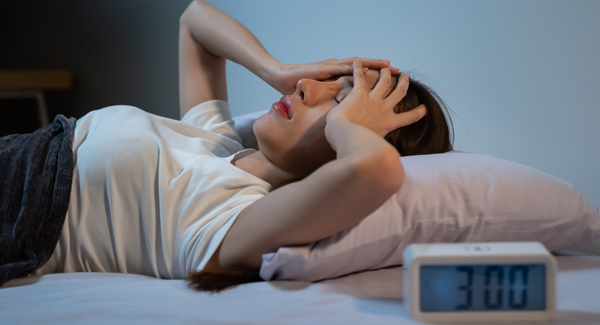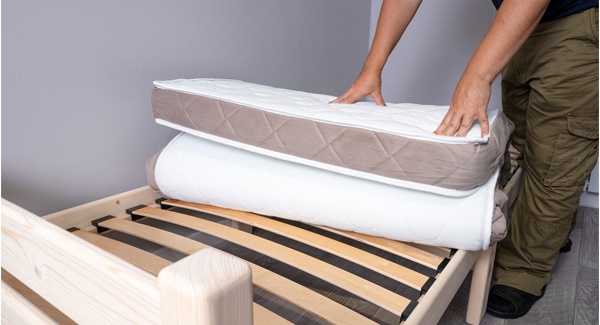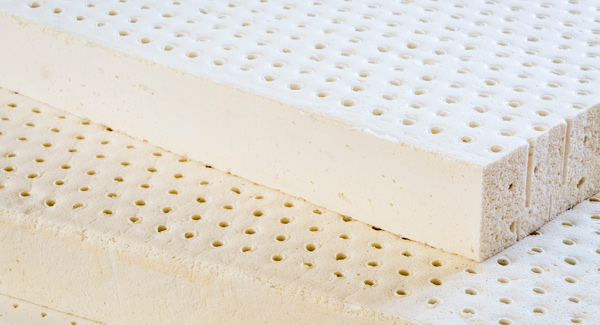Article navigation
- Tony Brown
Upholstered beds bring a warm and cosy feel to any bedroom. Combining luxury and functionality, upholstered beds come in various designs and sumptuous fabrics that work well in traditional and modern homes.
Upholstered beds create the perfect environment for rest and relaxation, whether that’s reading in bed, watching television, or weekend lie-ins with the family.
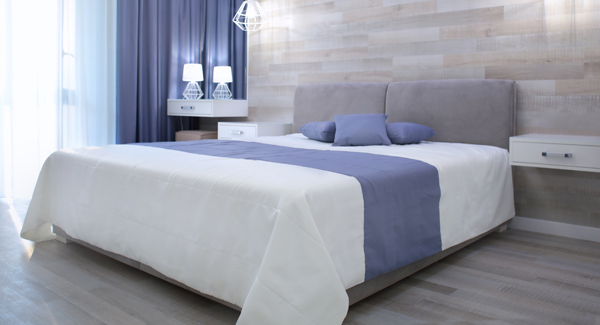
Types of upholstered bed
Upholstered beds come in various designs from traditional to modern, minimalist to maximalist. Some upholstered beds offer a truly bespoke experience by allowing you to add some finishing touches to the design, such as decorative studs, contrast piping, and style of leg.
The overall look of the bed is enhanced by the headboard, which comes in various distinctive shapes, and decorative features. Some headboards come with a buttoned back design to give the bed a timeless classic look. Other headboards come with a sleek fluted or panelled design to give the bed a more contemporary look.
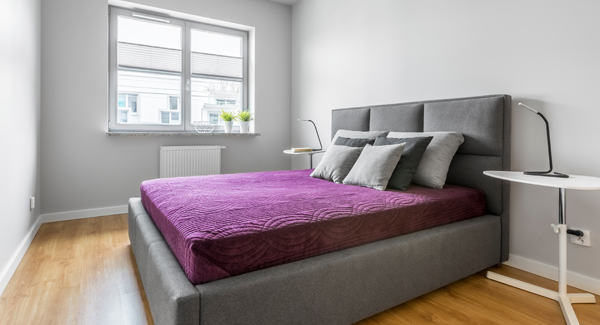
Bed frames may include a footboard to enhance the design while giving people the sensation of feeling safe, cosy, and cocooned in the bed. Other beds come with a low foot end for people who prefer a bed to feel more open and take up less room space.
When choosing an upholstered bed, you’ll also want to think carefully about the shape and style you choose. If you have children, you’ll want to avoid a bed with sharp edges. While a bed with a footboard may not be a good option for a taller person.
Also, consider the quality of the bed frame. Cheaper bed frames have a tendency to creak and may not provide adequate mattress support.
Here’s a look at some of the more popular upholstered bed designs.
Wingback beds
Some upholstered beds feature a wingback design which gives the bed a stylish and elegant look. The protruding wings are positioned on either side of the headboard. The shape of the wings varies depending on the style of the bed. Some wings are flat, while others may be scrolled or curved.
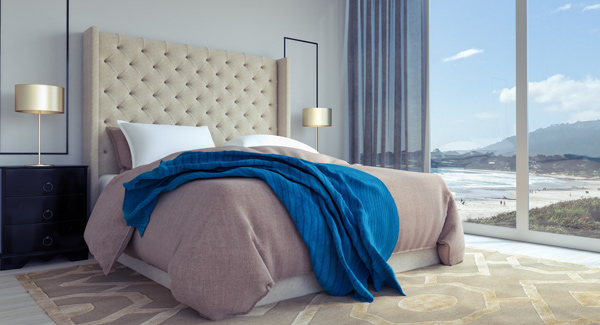
Sleigh beds
A sleigh bed is a distinctive style of bed characterised by a curved headboard and footboard, resembling a luxurious sleigh.
A striking centrepiece in any bedroom, a sleigh bed provides plenty of charm and elegance. Because of their curved design, sleigh beds tend to be larger than standard beds and are often heavier to move.
Ottoman beds
Ottoman beds are ideal for smaller rooms or homes with limited storage. The frame lifts up either from the end or side of the bed to provide access to the storage space underneath. Ottoman beds are available in various upholstered designs and colourways.
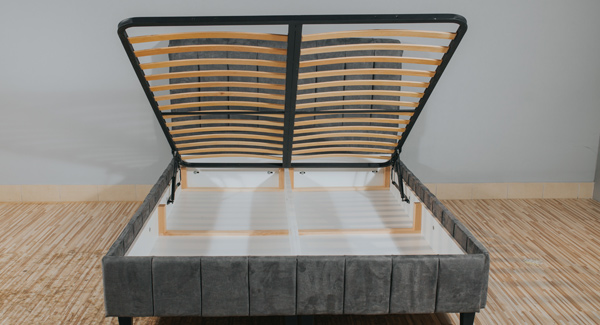
Materials
Upholstered beds can be fully or partially covered in a wide range of soft fabrics, or sometimes even in your own personal choice of material. The most commonly used fabrics include cotton, linen, velvet, and chenille.
Your choice of material will depend on your budget, lifestyle, and the look you want to create in your bedroom. It’s important to get the material right to ensure your bed remains in top condition.
Synthetic materials, such as polyester and acrylic, are entirely manmade and tend to be cheaper and less absorbent of liquids than natural materials, such as wool, silk, and cotton. In contrast, natural materials are more expensive but have a soft luxurious feel and are typically longer-lasting.
You can often order free fabric samples from the retailer before you order to help you decide if the fabric suits your décor.
Chenille
Chenille is a woven fabric with a soft texture. It’s a thick and durable material that can be made from several different fibres, such as cotton, wool, silk, and rayon.
Although chenille is durable, it does tend to stretch or shrink. Chenille also soaks up liquids fairly easily, so it’s important to clean up spills immediately to avoid stains. The pile can also be vulnerable to pet claws.
Microfiber
Microfiber is a synthetic material that has a soft, suede-like texture. The material is stain resistant making it an appealing option for families with children or pets.
Cotton
Cotton is a versatile fabric that is available in various colours and patterns. It is a breathable fabric with a soft and comfortable feel. However, cotton is susceptible to staining, which requires more effort to maintain, especially around children and pets.
Linen
Linen is a luxurious fabric with a smooth and cool texture. It is a durable fabric, which like cotton, is breathable. But linen does tend to wrinkle and stain fairly easily and requires more effort to maintain. As linen cannot withstand heavy wear and tear, it is often reserved for adult bedrooms or occasional rooms with less usage.
Velvet
Velvet has a lustrous sheen which can provide a high-end glamourous and luxurious look. It can be made from synthetic or natural fibres and has a soft and smooth texture.
Velvet can be durable and long-lasting if it is looked after correctly. Its smooth texture makes it easier to remove pet hairs, and because it has no raised weaves or loops, this helps prevent snagging and scratches.
Acrylic
Acrylic is a synthetic material often considered a cheaper imitation of wool. Acrylic is durable and is also resistant to soiling and fading.
Polyester
Polyester is a synthetic material which is often blended with other fibres. It is a strong and durable material that can withstand sunlight exposure and everyday wear and tear. It is also fairly resistant to soiling and fading.
Upholstered beds pros and cons
Apart from the aesthetic appeal, there are several factors to consider when choosing an upholstered bed. Weighing up the pros and cons will help you decide whether an upholstered bed is right for you.
Pros
Comfort
Upholstered beds provide a generous amount of padding, making them considerably more comfortable than wood or metal bed frames. The cushioned headboard is perfect for sitting up in bed, reading, watching television, or enjoying breakfast in bed.
Versatility
Upholstered beds are known for their versatility and practicality. They come in a vast array of designs, materials, and colours, so you can customise the look to suit almost any décor.
Some upholstered beds come with matching furniture, such as bedsides, drawers and ottomans, for a more polished and streamlined look.
Cons
Care and maintenance
Upholstered beds require special care to ensure they remain in good condition. Of course, regular cleaning will help keep dust and stains at bay, but if you find this off-putting, you may prefer a wood or metal bed instead.
Over time, upholstered beds collect dust and debris, which could trigger allergies and contribute to poor quality sleep. Some fabrics may be difficult to clean and may soil or stain easily. So if you enjoy breakfast in bed, you’ll need to take care to avoid stains, spillages and accidents. As fabric tends to be less durable than wood and metal, creases and pressure marks may form over time.
If you sit up in bed, hair and body oil can come into contact with the headboard. If the headboard is exposed to excessive amounts, this can leave a greasy stain which can discolour or ruin the fabric over time.
Upholstered beds can also absorb odours from pets, spills, and cigarettes, which may release a slightly unpleasant smell.
Some fabrics may also fade over time, especially if they are exposed to sunlight. However, some fabrics are more resilient to fading than others. So before choosing your fabric, carry out plenty of research on fabric types and colours to avoid unwanted discolouration.
Finally, if you have pets, make sure they don’t rub against the bed, as hair can easily get trapped in the material or allow them to snag the fabric.
Room space
Bedsteads typically take up more space than a divan because the mattress usually sits inside the frame. Upholstered beds tend to have thicker padding than other bed frames, and some designs can easily overwhelm a smaller bedroom. For instance, sleigh beds, with their curved design tend to take up more room space than standard beds.
So before choosing your bed, it’s important to measure the space correctly beforehand.
Mattress comfort and support
A common mistake that people make is prioritising the bed’s appearance over its comfort and support. If you’re buying the bed and mattress together, allow plenty of time to choose the mattress. Don’t just focus all your efforts on the aesthetics. Also, ensure the two are suitable for use together.
Upholstered beds often come with either a slatted or platform top base for the mattress to rest on. The type of base will affect the overall level of comfort and support. Sprung slats give a slightly bouncier feel, whereas solid slats and platform top bases provide a firmer feel.
Also, consider the overall height of the bed and whether you can comfortably get in and out of bed.
Caring for an upholstery bed
Knowing how to care for an upholstery bed will help to ensure it remains in good condition over time. It is difficult to provide precise instructions for cleaning an upholstered bed as advice will vary from fabric to fabric. If you’re in doubt, contact the retailer from whom you purchased the bed.
In the unfortunate event of a spillage or accident, it is important to act as quickly as possible. Avoid rubbing or soaking the material or allow the stain to dry and set. Absorb the spillage with a clean paper towel and avoid using soap or detergents on the upholstery.
Some cleaning fluids can affect the dye in certain fabrics, so having the bed professionally cleaned where necessary is advisable. You should also avoid using any stain repellent treatments, which may affect the material’s colour and performance.
Over time, upholstered beds can accumulate dirt and dust, which can accelerate wear and dull colours. To prevent dust and dirt build-up, carefully vacuum the upholstery at least weekly. Dust removal may be improved by gently brushing the fabric with a clean, soft brush.
Final thoughts
An upholstered bed is a stylish addition to any bedroom. But remember to choose a material that fits your lifestyle and budget.
Share this article

About the author
Tony Brown is the founder and creator of The Bed Consultant. His career in the bed industry began in 2002. After graduating from university with a degree in Business Administration, Tony joined one of the largest independent furniture retailers in the UK as a bed consultant. Tony has helped thousands of customers find the perfect mattress.

